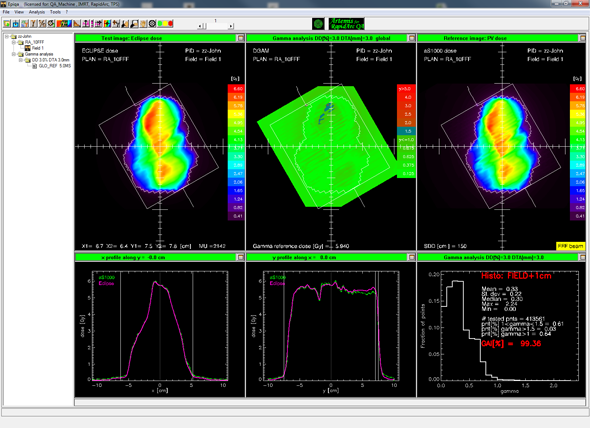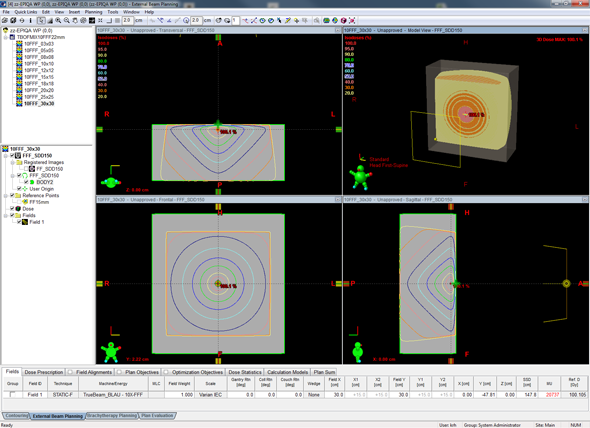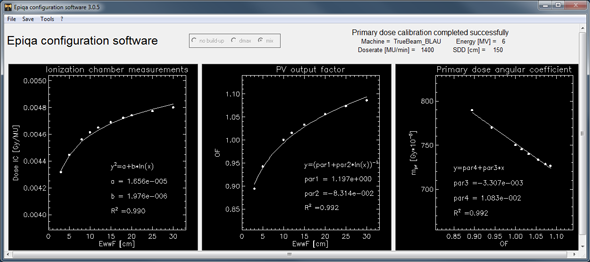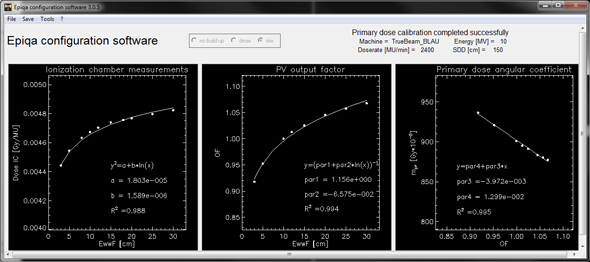Vienna, October 24, 2012 - Today KFJ successfully started Portal Dosimetry of FFF-Beams on the TrueBeam, using the highest available dose rates and EPIQA version 3.0.5.
Click all images to enlarge:

(EPIQA evaluation of 10FFF-RapidArc test plan with a Gamma criterion of 3%/3mm and active Jaw Tracking. Dose Rate was 2400 MU/min. See also the evaluation of the first clinical FFF-plan treated at KFJ, which can be found here.)
While Varian Portal Dosimetry is straightforward for flattened beams, the unflattened energies of the TrueBeam (6FFF and 10FFF) are currently not supported by Varian.
Epidos (again) is one step ahead and offers a solution to this problem with Version 3.0 of EPIQA, which supports all 5 Photon energies of the TrueBeam (6X, 6FFF, 10X, 10FFF, 15X).
Configuring the FFF Beams in EPIQA
The configuration steps for flattend and unflattend beams are very similar. The only difference is that for the highest dose rates (2400 MU/min for 10FFF), the source detector distance for the configuration should be moved from 100 cm to 150 cm. This avoids saturating the Portal Imager during image aquisition.
As for flattened beams, the first configuration step is to provide ionization chamber measurements ("output factors"). We preferred to calculate these factors in Eclipse instead of measuring them. The following screenshot is for 10FFF, 30x30 cm:
The phantom is at SSD = 147.8 cm, which is 150 cm - dmax for 10FFF. The dose prescription is 100 Gy, this gives an output factor of 207.37 MU/Gy for this field size.
The second step is the aquisition of integrated images for the same series of field sizes ranging from 3x3 cm to 30x30 cm, with the detector positioned at 150 cm. This completes the configuration of the primary beam.
Here are our results for 6FFF:
and 10FFF:
Four more images are acquired for the configuration of the MLC-transmitted beam. The measured MLC transmission also has to be entered in EPIQA configuration software. We used the same values as for the "Dosimetric Data" of Eclipse Beam Configuration: 1.0% for 6FFF and 1.2% for 10FFF.
As a last step, since the TrueBeam does not allow to acquire "raw" images, the dose profile for the same flattened energy (6X in the case of 6FFF, 10X for 10FFF) has to be provided, and also 2D-dose distributions for a 40x30 cm flattened beam and a 30x30 cm unflattend beam ("Gain correction"). These are calculated in Eclipse at the same distances as above: 150 cm - dmax.
Conclusion: FFF-RapidArc-QA solved!










